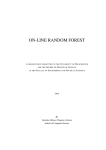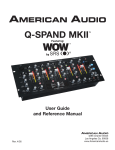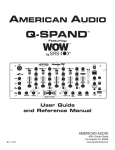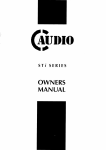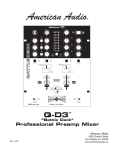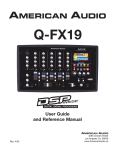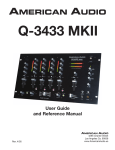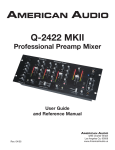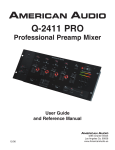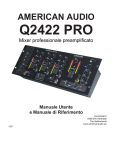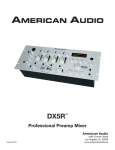Download American Audio Q-D6 SRS Specifications
Transcript
Q-D6 SRS ™ Featuring: is a trademark of SRS Labs, Inc. SRS WOW technology is incorporated under license from SRS Labs, Inc. American Audio 7/06 Los Angeles Ca. 90058 USA www.americanaudio.us Kerkrade Netherlands www.americandjeurope.com Q-D6 SRS™ Unpacking MAIN FEATURES....................................................................................................................................2 ELECTRICAL PRECAUTIONS................................................................................................................3 SAFETY PRECAUTIONS........................................................................................................................4 INTRODUCTION....................................................................................................................................5 SET-UP PRECAUTIONS.........................................................................................................................5 UNPACKING.........................................................................................................................................6 QUICK START.........................................................................................................................................6 FUNCTIONS AND CONTROLS TOP PANEL.................................................................................................................................7 FRONT AND REAR PANEL.......................................................................................................11 CLEANING......................................................................................................................15 CROSSFADER REPLACEMENT...........................................................................................................15 WARRANTY.........................................................................................................................................16 SPECIFICATIONS.....................................................................................................................17 Q-D6 SRS™ Main Features • • • • • SRS® WOW™ Processor Feather Crossfader 2 Phono, 1 Aux, 2 Line Inputs Fader “Q” Start Q-Start Compatible (for use with compatible American Audio CD Players ) • -26dB Rotary Kills for Treble, Bass and Mids on both channels • High output to headphones ©American • Extremely clean signal to noise ratio • Talk Over Switch • Master LED Level Indicator Indicates Master Signal Levels • Cue Mixing • Separate gain control for each channel • Hot Swap Crossfader • Separate Mic EQ Section • Balanced XLR Output Audio® - www.americanaudio.us - Q-D6 SRS™ Instruction Manual Page 2 Q-D6 SRS™ Electrical Safety Precautions ELECTRICAL PRECAUTIONS CAUTION RISK OF ELECTRIC SHOCK DO NOT OPEN The lightning flash with arrowhead symbol, within an equilateral triangle, is intended to alert the user to the presence of uninsulated "dangerous voltage" within the product's enclosure that may be of sufficient magnitude to constitute a risk of electric shock to persons. CAUTION: TO REDUCE THE RISK OF ELECTRIC SHOCK, DO NOT REMOVE THE COVER (OR BACK). THERE ARE NO USER SERVICEABLE PARTS INSIDE REFER SERVICE TO YOUR AUTHORIZED AMERICAN AUDIO® SERVICE TECHNICIAN. The exclamation point within an equilateral triangle is intended to alert the user to the presence of important operating and maintenance (servicing) instructions in the literature accompanying the appliance. IMPORTANT SAFETY INSTRUCTIONS READ INSTRUCTIONS — All the safety and operating instructions should be read before the product is operated. RETAIN INSTRUCTIONS — The safety and operating instructions should be retained for future reference. HEED WARNINGS — All warnings on the product and in the operating instructions should be adhered to. FOLLOW INSTRUCTIONS — All operating and use instructions should be followed. CLEANING — The product should be cleaned only with a polishing cloth or a soft dry cloth. Never clean with furniture wax, benzine, insecticides or other volatile liquids since they may corrode the cabinet. ATTACHMENTS — Do not use attachments not recommended by the product manufacturer as they may cause hazards. WATER AND MOISTURE — Do not use this product near water — for example, near a bathtub, wash bowl, kitchen sink, or laundry tub; in a wet basement; or near a swimming pool; and the like. ACCESSORIES — Do not place this product on an unstable cart, stand, tripod, bracket, or table. The product may fall, causing serious injury to a child or adult, and serious damage to the product. Use only with a cart, stand, tripod, bracket, or table recommended by the manufacturer, or sold with the product. Any mounting of the product should follow the manufacturer’s instructions, and should use a mounting accessory recommended by the manufacturer. CART — A product and cart combination should be moved with care. Quick stops, excessive force, and uneven surfaces may cause the product and cart combination to overturn. VENTILATION — Slots and openings in the cabinet are provided for ventilation and to ensure reliable operation of the product and to protect it from overheating, and these openings must not be blocked or covered. The openings should never be blocked by placing the product on a bed, sofa, rug, or other similar surface. This product should not be placed in a built-in installation such as a bookcase or rack unless proper ventilation is provided or the manufacturer’s instructions have been adhered to. POWER SOURCES —This product should be operated only from the type of power source indicated on the marking label. If you are not sure of the type of power supply to your home, consult your product dealer or local power company. LOCATION – The appliance should be installed in a stable location. NONUSE PERIODS – The power cord of the appliance should be unplugged from the outlet when left unused for a long period of time. GROUNDING OR POLARIZATION • If this product is equipped with a polarized alternating current line plug (a plug having one blade wider than the other), it will fit into the outlet only one way. This is a safety feature. If you are unable to insert the plug fully into the outlet, try reversing the plug. If the plug should still fail to fit, contact your electrician to replace your obsolete outlet. Do not defeat the safety purpose of the polarized plug. • If this product is equipped with a three-wire grounding type plug, a plug having a third (grounding) pin, it will only fit into a grounding type power outlet. This is a safety feature. If you are unable to insert the plug into the outlet, contact your electrician to replace your obsolete outlet. Do not defeat the safety purpose of the grounding type plug. POWER-CORD PROTECTION - Power-supply cords should be routed so that they are not likely to be walked on or pinched by items placed upon or against them, paying particular attention to cords at plugs, convenience receptacles, and the point where they exit from the product. OUTDOOR ANTENNA GROUNDING — If an outside antenna or cable system is connected to the product, be sure the antenna or cable system is grounded so as to provide some protection against voltage surges and built-up static charges. Article 810 of the National Electrical Code, ANSI/NFPA 70, provides information with regard to proper grounding of the mast and supporting structure, grounding of the lead-in wire to an antenna discharge unit, size of grounding conductors, location of antenna-discharge unit, connection to grounding electrodes, and requirements for the grounding electrode. See Figure A. LIGHTNING — For added protection for this product during a lightning storm, or when it is left unattended and unused for long periods of time, unplug it from the wall outlet and disconnect the antenna or cable system. This will prevent damage to the product due to lightning and power-line surges. POWER LINES — An outside antenna system should not be located in the vicinity of overhead power lines or other electric light or power circuits, or where it can fall into such power lines or circuits. When installing an outside antenna system, extreme care should be taken to keep from touching such power lines or circuits as contact with them might be fatal. OVERLOADING — Do not overload wall outlets, extension cords, or integral convenience receptacles as this can result in a risk of fire or electric shock. OBJECT AND LIQUID ENTRY - Never push objects of any kind into this product through openings as they may touch dangerous voltage points or short-out parts that could result in a fire or electric shock. Never spill liquid of any kind on the product. SERVICING — Do not attempt to service this product yourself as opening or removing covers may expose you to dangerous voltage or other hazards. Refer all servicing to qualified service personnel. DAMAGE REQUIRING SERVICE - Unplug this product from the wall outlet and refer servicing to qualified service personnel under the following conditions: • When the power-supply cord or plug is damaged. • If liquid has been spilled, or objects have fallen into the product. • If the product has been exposed to rain or water. • If the product does not operate normally by following the operating instructions. Adjust only those controls that are covered by the operating instructions as an improper adjustment of other controls may result in damage and will often require extensive work by a qualified technician to restore the product to its normal operation. • If the product has been dropped or damaged in any way. • When the product exhibits a distinct change in performance — this indicates a need for service. REPLACEMENT PARTS -- W hen replacement parts are required, be sure the service technician has used replacement parts specified by the manufacturer or have the same characteristics as the original part. Unauthorized substitutions may result in fire, electric shock, or other hazards. SAFETY CHECK - Upon completion of any service or repairs to this product, ask the service technician to perform safety checks to determine that the product is in proper operating condition. WALL OR CEILING MOUNTING — The product should not be mounted to a wall or ceiling. HEAT — The product should be situated away from heat sources such as radiators, heat registers, stoves, or other products (including amplifiers) that produce heat. ANTENNA LEAD IN WIRE GROUND CLAMP ANTENNA DISCHARGE UNIT (NEC SECTION 810-20) ELECTRIC SERVICE EQUIPMENT GROUNDING CONDUCTORS (NEC SECTION 810-21) GROUND CLAMPS Fig. A POWER SERVICE GROUNDING ELECTRODE SYSTEM (NEC ART 250, PART H) NEC — NATIONAL ELECTRICAL CODE ©American Audio® - www.americanaudio.us - Q-D6 SRS™ Instruction Manual Page 3 Q-D6 SRS™ Safety Precautions 1. For adult use only - Keep out of the reach of children. 2. Water and Moisture - The player should not be used near water - for example, near a bath tub, kitchen sink, laundry tub, in a wet basement or near a swimming pool, etc. Do not spill water or other liquids in to or on to your mixer. 3. Ventilation - The Mixer should be situated so that its location or position does not interfere with its proper ventilation. For example, the Mixer should not be situated on a bed, sofa, rug, or similar surface that may block the ventilation openings; or, placed in a built-in installation, such as a bookcase or cabinet that may impede the flow of air through the ventilation openings. 4. Heat - The Mixer should be situated away from heat sources such as radiators, heat registers, stoves, or other appliances (including amplifiers) that produce heat. 5. Power Sources - The Mixer should be connected to a power supply (wall outlet) only of the type described in the operating instructions or as marked on the Mixer. 6. Servicing -The user should not attempt to service the Mixer beyond that described in the operating instructions. There are no user serviceable parts inside. All other servicing should be referred to qualified service personnel. The Player should be serviced by qualified service personnel when: A. The power-supply cord or the plug has been damaged. B. Objects have fallen, or liquid has been spilled into the Mixer. C. The Mixer has been exposed to rain or water. D. The Mixer does not appear to operate normally or exhibits a marked change in performance. 7. Never disassemble or modify your unit in any way, doing so will void your manufactures warranty. ©American 8. Never plug this mixer in to a dimmer pack. 9. Do not let insecticides, benzene, or thinner come in contact with the surface of the unit. 10. This unit is intended for indoor use only, use of this product outdoors voids all warranties. 11. Always mount this unit in safe and stable matter. 12. Disconnect from main power before making any type of connection. 13. Cleaning - The mixer should be cleaned only as recommended by the manufacturer. Use a soft cloth to wipe down the outside of the unit. For stubborn stains moisten a soft cloth with glass cleaner or other mild detergent to wipe away any stains. Use a soft cloth to wipe any residual cleaner. Never use volatile cleaners such as benzene, solvent, or thinner to clean your unit, these cleaners will damage the units surface. 14. Handle the power supply cord carefully. Do not damage or deform; it may cause electric shock or malfunction when used. Hold plug attachment when removing from wall outlet. Do not pull on the cord. 15. To avoid electric shock, do not open the top cover when the unit is plugged in. If problems occur with the unit, call American Audio® customer support. 16. Do not place metal objects or spill any liquids inside or on the mixer. Electric shock or malfunction may occur. 17. Power Cord Protection - Power supply cords should be routed so that they are not likely to be walked on or pinched by items placed upon or against them, paying particular attention to cords at plugs, convenience receptacles, and the point where they exit from the mixer. Route your power cord out of the way of foot traffic. 18. Always have the front gain controls set to their lowest level during initial power-up to prevent speaker damage. Audio® - www.americanaudio.us - Q-D6 SRS™ Instruction Manual Page 4 Q-D6 SRS™ Introduction Introduction: Congratulations and thank you for purchasing the American Audio® Q-D6 SRS™ mixer. This mixer is a representation of American Audio’s continuing commitment to produce the best and highest quality audio products possible at an affordable price. The Q-D6 SRS™ comes with a 2 year limited warranty! Please read and understand this manual completely before attempting to operate your new mixer. This booklet contains important information concerning the proper and safe operation of your new mixer. Customer Support: American Audio® provides a toll free customer support line, to provide set up help and to answer any question should you encounter problems during your initial set up or operation. You may also visit us on the web at www.americanaudio.us for any comments or suggestions. Service Hours are Monday through Friday 9:00 a.m. to 4:30 p.m. Pacific Standard Time. Voice: (800) 322-6337 Fax: (323) 582-2610 E-mail: [email protected] To purchase parts online visit http://parts.americandj.com Caution! There are no user serviceable parts inside this mixer. Do not attempt any repairs yourself, doing so will void your manufactures warranty. In the unlikely event your mixer may require service, please contact American Audio® customer support. Do not discard the packing carton in the trash. Please recycle when ever possible. Q-D6 SRS™ Set-Up Precautions Please be sure to make any connections before plugging the mixer in to an electrical outlet. All fader and volume controls should be set to zero or minimum position, before the mixer is switched on. If the mixer has been exposed to drastic temperature fluctuation (e.g. after transportation), do not switch on the mixer immediately. The arising condensation of water might damage your device. Leave the device switched off until it has reached room temperature. Operating Determinations: • When installing this mixer, please make sure that the device is not exposed or will not be exposed to extreme heat, moisture or dust! • Do not operate the mixer in extremely hot (more than 30°/100°F) or extremely cold (less than 5°C/40°F) surroundings. • Keep the unit out of direct sunlight and away from heaters. • Operate the mixer only after becoming familiar with its functions. Do not permit operation by persons not qualified for operating the mixer. Most damages are the result of unprofessional operation! • Do not attempt to operate this mixer if the power cord has been frayed or damaged. • Disconnect from main power before making any type of connection. • Do not attempt to operate this mixer, if it becomes damaged in any way. • Never operate this mixer when it’s covers are removed. • To reduce the risk of electrical shock or fire, do not expose this mixer to rain or moisture. • This mixer is intended for indoor use only, use of this product outdoors voids all warranties. • During long periods of non-use, disconnect the mixer’s main power. ©American Audio® - www.americanaudio.us - Q-D6 SRS™ Instruction Manual Page 5 Q-D6 SRS™ Unpacking Every Q-D6 SRS™ has been thoroughly tested and has been shipped in perfect operating condition. Carefully check the shipping carton for damage that may have occurred during shipping. If the carton appears to be damaged, carefully inspect your mixer for any damage and be sure all equipment necessary to operate the mixer has arrived intact. In case damage has been found or parts are missing, please contact our toll free customer support number for further instructions, please do not return the mixer to your dealer. Q-D6 SRS™ Quick start instructions American Audio would like to thank for your purchase of this great product. For those of you that are to impatient to read the entire user manual we have compiled these quick start instructions. We hope that you will at least read through these instructions to familiarize yourself with the basic understanding of the unit. The Q-D6 SRS is part of American Audio’s continuing evolution in audio technology. This unit has been built and designed with the typical DJ in mind, by DJ’s. We have attempted to provide you with the most reliable product on the market by using only components made from quality products. MASTER LEVEL - Use this level control to set your volume output. Try never to send an output of more than +4dB to your system. Signal at levels higher than this will start to distort and may cause damage to your system and speakers. Remember that a distorted signal from you mixer will only be multiplied throughout your system. CHANNEL GAIN LEVEL - The channel trim levels are not to be used as volume controls, never use the channel gain to set the output volume. These controls are used to aid in distortion control. Use these control to preset your signal level before the crossfader. With your channel faders in the maximum position, use the channel trim level to set an average output level of about +4dB on you master level meter. HEADPHONES - To avoid sever hearing damage, always be sure the headphone level is set to minimum before plugging them in. Never put the headphone on without making sure the headphone level is turned down. MIC - The mic connector uses a 1/4” jack unbalanced connector. The DJ mic has an independent volume control. When feedback occurs when using the mic, try lowering the “low” level this may reduce the feedback. Always leave the mic level to it’s minimum level when not in use. Q-START FEATURE - This function works in conjunction with a compatible American Audio or American DJ “Q”Start CD player. When used with a compatible CD player, you can use the crossfader to start and stop the CD Player with the slide of the fader. The ON/OFF “Q ”START switch activates this FADER “Q ”START feature. ©American Audio® - www.americanaudio.us - Q-D6 SRS™ Instruction Manual Page 6 Q-D6 SRS™ Controls and Features Top Panel 19 1 18 2 3 4 17 5 6 16 7 15 14 8 13 12 11 9 10 1. SOURCE SELECTOR SWITCH - These switches are used to select the input source assigned to each channel. Each channel may only be assigned one input source at a time. This switch must be in the “phono” position for turntable operation. 2. POWER L.E.D. - This L.E.D. will glow when the power is switched on. 3. CHANNEL GAIN CONTROL - This adjustment is used to adjust an audio source signal input gain for a channel. Never use the gain control to adjust output volume. Setting the gain level properly will ensure a clean output signal. To properly set the gain level controls: 1. Be sure the MASTER VOLUME CONTROL (4) is set to level 4. 2. Set the CHANNEL FADER (9) to level 8. 3. Begin playback on an audio source connected to the channel you are adjusting. 4. Use the Gain Control (3) to adjust an average output volume of +4 dB. 5. Repeat this step for all channels 4. MASTER VOLUME CONTROL - This rotary knob is used to control the master output level (volume). To avoid distorted output try to maintain an average output signal level +4 dB. Be sure this volume ©American Audio® - www.americanaudio.us - Q-D6 SRS™ Instruction Manual Page 7 Q-D6 SRS™ Controls and Features Cont. control is always set to zero before turning the unit on. 5. CUE LEVEL VOLUME CONTROL - This knob is used to adjusts the headphone volume output level. Turn the knob in a clockwise direction to increase the headphone volume. 6. CUE MIXING CONTROLLER - This knob selects the channel for monitoring. The monitor signal comes from the Prefader. This means it will not be affected by the channel faders. You can monitor each channel individually. Connect your headphones to the HEADPHONES JACK (33). Turn the CUE MIXING CONTROL to CUE and select the desired channels with the Cue buttons. When you turn the CUE MIXING CONTROL to PGM (PFL switches without function), you can cue the output signal of the mixer. If the CUE MIXING CONTROL is set to the center position, you can cue both the channel signal you selected and the output signal. With the CUE LEVEL control, you can adjust the phones volume without changing the output signal. 7. CHANNEL EQUALIZER - All of the channels include a three-band signal EQ. These controls are used to increase or decrease the LOW’s, MID’s, and HI’s of the output signal. CHANNEL TREBLE CONTROL - This knob is used to adjust the treble levels of a channel allowing for a maximum treble gain of 9dB or maximum decrease of -26dB. Turning the knob in a counter-clockwise direction will decrease the amount of treble applied to a channel signal, turning the knob in a clockwise direction will increase the amount of treble applied to a channel signal. CHANNEL MIDRANGE CONTROL - This knob is used to adjust the midrange levels of a channel allowing for a maximum midrange gain of 9dB or maximum decrease of -26dB. Turning the knob in a counter-clockwise direction will decrease the amount of midrange applied to a channel signal, turning the knob in a clockwise direction will increase the amount of midrange applied to a channel signal. CHANNEL BASS CONTROL - This knob is used to adjust the low frequency levels of a channel allowing for a maximum bass gain of 9dB or maximum signal decrease of -26dB. Turning the knob in a counter-clockwise direction will decrease the amount of bass applied to a channel signal, turning the knob in a clockwise direction will increase the amount of bass applied to a channel signal. 8. CUE BUTTONS - These buttons are used to activate a channels “CUE” mode. A red LED on the Cue button will glow when that channels cue mode is activated. Cue mode will send a channels incoming signal to the headphones. The cue level is adjusted by the CUE LEVEL VOLUME KNOB (5). Be sure the cue level is set to minimum before putting a pair of headphones on. Be sure the CUE MIXING KNOB (6) is turned to the “CUE” position to hear the selected channel source. 9. CHANNEL FADER - These faders are used to control the output signal of any source assigned to its particular channel. 10. FEATHER FADER PLUS CROSSFADER - This fader is used to blend the output signals of channels one and two together. When the fader is in the full left position (channel 1), the output signal of channel one will be controlled by the master volume level. The same fundamentals will apply for channel two. Sliding the fader from one position to another will vary the output signals of channels one and three respectively. When the crossfader is set in the center position, the output signals of both the channels one and channels two will be even. The Channel three fader will work when the crossfader is any position. 11. Q-START ON/OFF SWITCH - This function works in conjunction with a compatible American ©American Audio® - www.americanaudio.us - Q-D6 SRS™ Instruction Manual Page 8 Q-D6 SRS™ Controls and Features Cont. Audio® or American DJ® “Q” Start CD player. When used with a compatible CD player, you can use the crossfader to start and stop the CD play. The ON/OFF “Q” START switch activates the fader “Q” start feature. When the fader “Q” start feature is activated sliding the CROSSFADER (10) from left to right will play or cue any CD player connected to the CONTROLLER JACKS (20) on the rear of the unit. For example, connect a compatible dual CD player connect to mixer channels one and two (refer to your CD player manual for proper set-up). Be sure the Fader “Q” Start feature is activated on both channels. Slide the crossfader to the channel one position (full left) and begin playback on CD drive one. Slide the crossfader to the channel position (far right). This will immediately trigger the play function on CD drive two and return CD drive one to cue mode. To return to normal fader operation turn the Fader “Q” Start ON/OFF SWITCH to the OFF position. 12. WOW CONTROL - This button is used to activate the SRS ® WOW™ Process created by SRS Labs. The WOW™ process is a combination of 3D Stereo Process and the TRU BASS™ Process. WOW™ creates extraordinary enhancement to the listening experience. Ordinary stereo presents a limited spatial presentation, and often lack-luster bass (low frequency) performance. Any sound system can deliver an audio performance with drastically improved image size, dynamics and immersion when playing a signal processed with WOW™. Because the WOW™ effect combines the 3D Stereo™ Process and the TRU BASS™ Process, the processing of the spatial cues surrounds the listener with a holographic representation of the performance. In addition bass becomes deep, rich and controlled through means that don’t require a speaker with a large woofer or cabinet size. In essence you may eliminate the need of a separate sub-woofer. 13. TRU BASS CONTROL - This button is used to activate the SRS ® (Sound Retrieval System®) TRU BASS™ Process. TruBass circuity actively monitors the low-frequency content of an audio signal and optimizes the frequency and amplitude spectrum of the output signal to enhance bass perception. Whether you are limited by space, cost or implementation, for bass previously believed impossible. This process creates deep, rich bass in headphones and speaker systems that have poor or little bass response. Sub-woofer performance will be enhanced substantially. Unprecedented bass response will virtually eliminates the need for large speakers to create low frequency fundamental tones and will in several case eliminate the need for a sub-woofer all together. Be sure that the TRU BASS™ process will not color the midrange or create bass not present on recordings. This process will only define any bass present on a recording. 14. 3D ST CONTROL - This button is used to activate the SRS ® (Sound Retrieval System®) 3D Stereo Process. SRS® retrieves the spatial information from recordings and restores the original three-dimensional sound field. As a result, the reproduced sound is much closer to a live performance. Like live performances, SRS® has no critical listening position (sweet spot). Listeners can move around the room and continue to be immersed in full three-dimensional sound. A microphone does not possess the ability to interpret the direction a sound is coming from in the same way that the human ear does. However, when the audio source is recorded, directional audio cues are still present in the recording. By breaking down the stereo signal into its various signal components, it is possible to isolate and restore these spatial cues and place them in the proper space relative to the direct sounds, such as a soloist or dialogue. These spatial cues are restored by the use of Head Related Transfer Functions (HRTFs), which process ambient sounds via patented frequency response correction curves. 15. WIDTH CONTROL - This knob is used to control the amount of SRS® 3D process that is applied to the output source signal. 16. TRUE BASS LEVEL - This knob is used to control the amount of "TRU BASS" process that is applied to the output source signal. ©American Audio® - www.americanaudio.us - Q-D6 SRS™ Instruction Manual Page 9 Q-D6 SRS™ Controls and Features Cont. 17. MICROPHONE SECTION - These controls are used to adjust the microphone volume level, treble level, and bass levels. MICROPHONE VOLUME - This knob is used to regulate the microphone output volume. Turning the knob in a clockwise direction will increase the volume level. MICROPHONE TREBLE CONTROL - This knob is used to adjust the treble levels of the Microphone with a maximum signal gain of 10dB or maximum signal decrease of -10dB. Turning the knob in a counter-clockwise direction will decrease the amount of treble applied to the microphone signal, turning the knob in a clockwise direction will increase the amount of treble applied to microphone signal. MICROPHONE BASS CONTROL - This knob is used to adjust the low frequency levels of the microphone with a maximum signal gain of 10dB or maximum signal decrease of -10dB. Turning the knob in a counter-clockwise direction will decrease the amount of bass applied to the microphone signal, turning the knob in a clockwise direction will increase the amount of bass applied to microphone signal. 18. TALKOVER CONTROL - This function decreases all signal output except for the microphone signal. 19. MASTER VOLUME LEVEL INDICATORS - The dual MASTER LEVEL LED indicators are used to detail the master output level. The meters will detail the output level of both the left and right channels. ©American Audio® - www.americanaudio.us - Q-D6 SRS™ Instruction Manual Page 10 Q-D6 SRS™ Controls and Features Cont. Rear Panel 32 20 31 30 29 28 27 21 22 26 25 24 23 20. PLAYER CONTROL - These jacks are used to control the “Q-Start” function between the mixer and a compatible American Audio CD Player. Input mini plugs from CD player controller into these jacks, input CD 1 into jack A and CD 2 into jack B. 21. GND (GROUND TERMINAL) - Connect each of your turntables ground leads to either of the two ground terminal. This will reduce the humming and popping noises associated with magnetic phono cartridges. 22. MICROPHONE 2 CONNECTOR - This jack is used to a connect a microphone to the mixer. Connect you microphone via 1/4 inch (6.3mm) jack. The signal volume will be controlled by the MIC LEVEL (17). The bass and treble levels can also be adjusted by the built-in MICROPHONE EQ (17). 23. CHANNEL 1: PHONO 1 INPUT JACKS - Connect turntables equipped with MM pickup cartridge to PHONO inputs (All DJ turntable use MM pick-up cartridges). The red colored RCA jack represents the right channel input and the white represents the left channel input. 24. CHANNEL 1: LINE 1 RCA INPUT JACKS - DO NOT CONNECT TURNTABLES TO THESE JACKS! These Jacks are used for line level inputs. Connect CD players or Tape Decks to LINE inputs. Line level musical instruments with stereo outputs such as Rhythm Machines or Samplers should also be connected to LINE inputs. Turntables should only be connected to “Phono” inputs. The red colored RCA jack represents the right channel input and the white represents the left channel input. 25. CHANNEL 2: PHONO 2 INPUT JACKS - Connect turntables equipped with MM pickup cartridge to PHONO inputs (All DJ turntable use MM pick-up cartridges). The red colored RCA jack represents the right channel input and the white represents the left channel input. 26. CHANNEL 2: LINE 2 RCA INPUT JACKS - DO NOT CONNECT TURNTABLES TO THESE JACKS! These Jacks are used for line level inputs. Connect CD players or Tape Decks to LINE inputs. Line level musical instruments with stereo outputs such as Rhythm Machines or Samplers should also be connected to LINE inputs. Turntables should only be connected to “Phono” inputs. The red colored RCA ©American Audio® - www.americanaudio.us - Q-D6 SRS™ Instruction Manual Page 11 Q-D6 SRS™ Controls and Features Cont. jack represents the right channel input and the white represents the left channel input. 27. CHANNEL 3: LINE 3 AUX INPUT JACKS - DO NOT CONNECT TURNTABLES TO THESE JACKS! These Jacks are used for line level inputs. Connect CD players or Tape Decks to LINE inputs. Line level musical instruments with stereo outputs such as Rhythm Machines or Samplers should also be connected to LINE inputs. Turntables should only be connected to “Phono” inputs. The red colored RCA jack represents the right channel input and the white represents the left channel input. 28. REC OUT - This is a low current unbalanced output source designed for various tape and CD recorders. The Record Out (REC OUT) level is dictated by the CHANNEL FADER LEVEL (9), it is not influenced by the MASTER VOLUME CONTROL (4). 29. RCA MASTER OUTPUTS - The Master Output includes a pair of RCA UNBALANCED JACKS (24). The RCA jacks send a low current unbalanced output signal. 30. BALANCED XLR MASTER OUTPUTS - The Master Output includes a pair XLR Balanced JACKS as well as a pair RCA UNBALANCED JACKS (29). The 3-pin XLR jacks send a high current balanced output signal. These jacks should be used when you will be driving an amp or other audio equipment with a balanced input, or whenever you will be running a signal line greater than 15 feet. Always, use these jacks whenever possible. 31. 9V AC INPUT - Connect the included power supply to this input, or any other 9v power adapter. 32. MAIN POWER SWITCH - This is the main power ON/OFF button. An L.E.D. located on the front of the mixer will glow green when the power is ON. Before main power is applied, be sure you have made all connections to the mixer. Also be sure your amplifier(s) is(are) tuned off. Remember to avoid damaging pops, the mixer should be powered on first and turned off last. 34 33 33. HEADPHONE OUTPUT JACK - This jack is used to connect your headphones to the mixer allowing you to monitor the cue source. Use headphones only rated at 8 ohms to 32 ohms. Most DJ headphones are rated at 16 ohm, these are highly recommended. Always be sure the CUE LEVEL VOLUME (5) is set to minimum before you put the headphones on. 34. MICROPHONE CONNECTOR - This jack is used to a connect a microphone to the mixer. Connect you microphone via 1/4 inch (6.3mm) jack. The signal volume will be controlled by the MIC LEVEL (17). The bass and treble levels can also be adjusted by the built-in MICROPHONE EQ (17). ©American Audio® - www.americanaudio.us - Q-D6 SRS™ Instruction Manual Page 12 Q-D6 SRS™ Typical Mixer Set-Up CASSETTE DECK ©American Audio® - www.americanaudio.us - Q-D6 SRS™ Instruction Manual Page 13 Q-D6 SRS™ Typical Mixer Output Connections Set-Up RCA to RCA Patch Cables RCA to 1/4” Patch Cables CASSETTE DECK Speaker Cables ©American Audio® - www.americanaudio.us - Q-D6 SRS™ Instruction Manual Page 14 Q-D6 SRS™ Cleaning Due to fog residue, smoke, and dust, cleaning the mixer should be carried out periodically to residue build up. 1. Use normal glass cleaner and a soft cloth to wipe down the outside casing. 2. Use a cleaner specially designed for electronics to spray in and around the knobs and switch. This will reduce small particle built up that can effect the proper operation of the mixer. 3. Clean should be carried out every 30-60 days. 4. Always be sure to dry all parts completely before plugging the mixer in. Cleaning frequency depends on the environment in which the mixer operates (i.e. smoke, fog residue, dust, dew). Q-D6 SRS™ Cross Fader Replacement The crossfader is “Hot Swapable” which means it may be replaced at any time, even when power is applied. Only replace with American Audio Part Feather Fader Plus. Replacing with any other model fader may seriously damage your mixer. Replacing the Crossfader: 1. 2. 3. 4. 5. Disconnect the mixers main power supply Using a Phillips screw driver, unscrew the two stainless steel retaining screws that hold the crossfader in place. Gently remove the crossfader from its seated position. You may need to wiggle the crossfader slightly to remove it. After removing the crossfader, disconnect the ribbon cable that attaches the crossfader to the PC board. Grasp the crossfader by its base and pull the ribbon cable by its connector not the actual cables. The connector is designed to only fit one way, so don’t worry about the connectors orientation. Connect the new crossfader to the ribbon cable and replace in reverse order. ©American Audio® - www.americanaudio.us - Q-D6 SRS™ Instruction Manual Page 15 Q-D6 SRS™ Registration The Q-D6 SRS™ carries a one year (365 days) limited warranty. Please fill out the enclosed warranty card to validate your purchase. All returned service items whether under warranty or not, must be freight pre-paid and accompany a return authorization (R.A.) number. The R.A. number must be clearly written on the outside of the return package. A brief description of the problem as well as the R.A. number must also be written down on a piece of paper and included in the shipping container. If the unit is under warranty, you must provide a copy of your proof of purchase invoice. You may obtain a R.A. number by contacting customer support at (800) 322-6337. Q-D6 SRS™ Warranty 1-YEAR LIMITED WARRANTY A. American Audio® hereby warrants, to the original purchaser, American Audio® products to be free of manufacturing defects in material and workmanship for a period of 1 Year (365 days) from the date of purchase. This warranty shall be valid only if the product is purchased within the United States of America, including possessions and territories. It is the owner’s responsibility to establish the date and place of purchase by acceptable evidence, at the time service is sought. B. For warranty service, send the product only to the American Audio® factory. All shipping charges must be pre-paid. If the requested repairs or service (including parts replacement) are within the terms of this warranty, American Audio® will pay return shipping charges only to a designated point within the United States. If the entire instrument is sent, it must be shipped in its original package. No accessories should be shipped with the product. If any accessories are shipped with the product, American Audio® shall have no liability whatsoever for loss of or damage to any such accessories, nor for the safe return thereof. C. This warranty is void if the serial number has been altered or removed; if the product is modified in any manner which American Audio® concludes, after inspection, affects the reliability of the product; if the product has been repaired or serviced by anyone other than the American Audio® factory unless prior written authorization was issued to purchaser by American Audio®; if the product is damaged because not properly maintained as set forth in the instruction manual. D. This is not a service contract, and this warranty does not include maintenance, cleaning or periodic checkup. During the period specified above, American Audio® will replace defective parts at its expense, and will absorb all expenses for warranty service and repair labor by reason of defects in material or workmanship. The sole responsibility of American Audio® under this warranty shall be limited to the repair of the product, or replacement thereof, including parts, at the sole discretion of American Audio®. All products covered by this warranty were manufactured after January 1, 1990, and bear identifying marks to that effect. E. American Audio® reserves the right to make changes in design and/or improvements upon its products without any obligation to include these changes in any products theretofore manufactured. F. No warranty, whether expressed or implied, is given or made with respect to any accessory supplied with products described above. Except to the extent prohibited by applicable law, all implied warranties made by American Audio® in connection with this product, including warranties of merchantability or fitness, are limited in duration to the warranty period set forth above. And no warranties, whether expressed or implied, including warranties of merchantability or fitness, shall apply to this product after said period has expired. The consumer’s and or Dealer’s sole remedy shall be such repair or replacement as is expressly provided above; and under no circumstances shall American Audio® be liable for any loss or damage, direct or consequential, arising out of the use of, or inability to use, this product. G. This warranty is the only written warranty applicable to American Audio® Products and supersedes all prior warranties and written descriptions of warranty terms and conditions heretofore published. ©American Audio® - www.americanaudio.us - Q-D6 SRS™ Instruction Manual Page 16 Q-D6 SRS™ Specifications Model: Q-D6 SRS, Professional 3 Channel Preamp Mixer POWER SUPPLY: AC9V, 1000mA DIMENSIONS: 10”W x 12.12”D x 3.97”H /254 x 308 x 101 mm WEIGHT: 6.6 Lbs. / 3 Kgs FEATURES: SRS® WOW™ Audio Processor for Master Output CD Play Control By Crossfader CROSSFADER: Feather Fader Plus - VCA detecting fader start control Low grounding impedance crossfader POWER CONSUMPTION: 5W typical, 7W w/ full headphone output HEADPHONE IMPEDANCE: 32 Ohms ENVIRONMENTAL CONDITION: Operating Temperature: 5 to 35 deg. C; Humidity: 25 to 85% RH (non-condensing); Storage Temperature: -20 to 60 ˚C Input Sensitivity (Level/Impedence): LOAD=100K OHM LINE, AUX: -14dB (200mV)/10K Ohms ±2dB PHONO: -50dB (3.16mV)/47K Ohms ±2dB MICROPHONE: -60dB (1mV) /2.2K Ohms ±2dB Output Sensitivity (Level/Impedence): Note: 0dBV=1Vrms, LOAD=100K OHM 600 Ohms / +4dB (1.23V) +/-2dB MASTER OUT (XLR): MASTER OUT (RCA): 300 Ohms / 0dB (1V) +/-2dB REC OUT (RCA): -10dB (316mV)/2.2K Ohms +/-2dB PHONES (LOAD=32 OHMS): 0dB (1V)/33 Oms +/-2dB (Cue Mixing at Center) Maximum Output (Load = 100K OHM, THD = 1%) MASTER (RCA): MORE THAN 18dB (8V) PHONES (Load=32 ohms): MORE THAN 4dB (1.6V) CHANNEL BALANCE: Within 3dB Frequency Response: LINE, AUX: PHONO: MICROPHONE: 20Hz - 20KHz, +/-2dB 20Hz - 20KHz, +2/-3dB (RIAA) 20Hz - 20KHz, +2/-3dB Output Noise (MAX. GAIN, EQ FLAT, W/ 20KHz LPF, A-WEIGHTED): LINE/AUX: MORE THAN 90dB PHONO: MORE THAN 70dB MIC: MORE THAN 60dB THD + N Total Harmonic Distortion (Master Out, Maximum Gain, W/20Khz LPF, EQ Flat, SRS® Off): LINE, AUX: Less than 0.02% 20-20KHz PHONO: Less than 0.1% at 1KHz (A-Weighted) MIC: Less than 0.2% at 1KHz (A-Weighted) CROSS TALK (MaximumGain, Master Output, EQ Flat, SRS® Off): LINE, AUX: MORE THAN 60dB AT 1KHz between L and R MORE THAN 70dB AT 1KHz between Channels Channel Equalizer: BASS: MID: TREBLE: ©American 9 +/-2dB at 70Hz / -23 at 70Hz 9 +/-2dB at 1KHz / -23 at 1KHz 9 +/-2dB at 13KHz / -14 +/-3dB at 13KHz Audio® - www.americanaudio.us - Q-D6 SRS™ Instruction Manual Page 17 Q-D6 SRS™ Specifications Microphone Equalizer: BASS: TREBLE: 10 +/-2dB at 100Hz / -10 +/-2dB at 100Hz 10 +/-2dB at 10KHz / -10 +/-2dB at 10KHz Mic Talkover: -14 +/-2dB SRS® Gain: (Line = -24dBV Input, Maximum gain, TRU BASS™ and Width at Maximum position) +14.5 +/-4dB at 100Hz TRU BASS™: 3D ST: +8.5 +/-4dB at 100Hz (Single L or R Input) WOW™: +15.5 +/-4dB at 100 & 10KHz (Single L or R Input) SRS® Output Noise: (A-Weighted, Master Volume Min.) TRU BASS™: Less Than -66dBV (TRU BASS™ VR MAX) 3D ST: Less Than -80dBV (WIDTH VR MAX) WOW™: Less Than -65dBV (BOTH VR MAX) Fader Kill: CHANNEL FADER: CROSSFADER: More Than 75dB at 1KHz More Than 70dB at 1KHz ©American Audio® - www.americanaudio.us - Q-D6 SRS™ Instruction Manual Page 18 is a trademark of SRS Labs, Inc. SRS WOW technology is incorporated under license from SRS Labs, Inc. ©American Audio® A Division of the American DJ Group of Companies 4295 Charter Street Los Angeles, CA 90058 USA Tel: 323-582-2650 Fax: 323-582-2610 Web: www.americanaudio.us E-mail: [email protected]



















